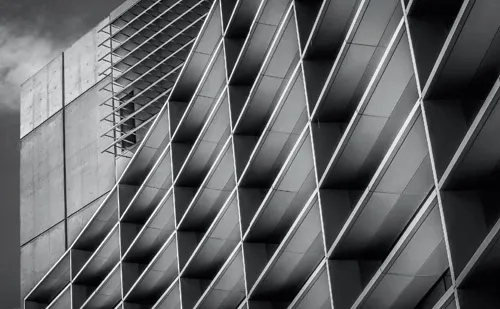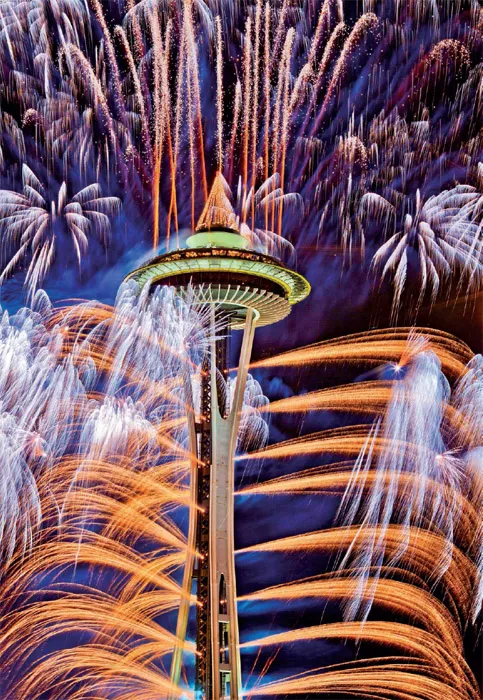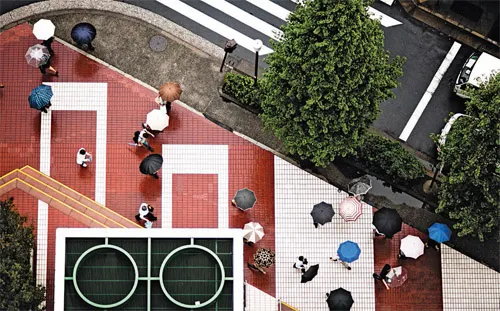![]()
PHOTOGRAPHY SUBJECTS
![]()
The secret to shooting fireworks, says John Cornicello, is a low ISO and a steady camera. “A lot of people think, ‘Oh, it is dark out. I need a high ISO or a wide aperture, or a short shutter speed,’” John says. “In reality, while the sky is dark, the fireworks are very bright.” Bright and close in sequence, these fireworks were captured with an ISO of 100 and a small aperture (f/14). Experiment with shutter speeds from 1–5 sec to control the trails from the firework blasts.
FIREWORKS
WHETHER IT’S A NATIONAL HOLIDAY or a small-town celebration, fireworks shows draw huge crowds who “ooh” and “aah” with each burst of light. Capturing these dazzling displays on camera can be challenging, but with a little extra effort, you’ll come home exhilarated from the evening’s events, and packing a memory card full of spectacular images.
GETTING STARTED
Fireworks shows are often few and far between, so even if you’ve shot them before, it’s wise to brush up on the basics before heading out to the next pyrotechnics display. Being prepared with the right gear is critical, of course. DSLRs and mirrorless cameras with an interchangeable lens (ILCs) work best, since they offer the kind of exposure control that keeps you on top of conditions that change from one shot to the next. It’s even possible to grab good shots with a compact camera equipped with a special fireworks mode that holds the shutter open long enough to capture those magical bursts of light.
Location has a big impact, so scout for a good spot early in the evening or even the day before. Shooting near water adds reflection that will double the dazzle. Keep in mind that you want to be far enough away that the fireworks pop in front of you—rather than directly above you—and try to stay upwind, so smoke doesn’t affect the clarity of your images. Fireworks tend to be unpredictable, making it tough to set up a perfect composition. So keep shooting and experiment with camera settings to stack the odds in favor of nabbing some star-spangled shots.
Here, David Johnson rendered the fireworks bursts as defocused blurs radiating out from a center point. As each burst flew outward, he evenly rotated the focusing ring until the image was sharp, transforming the fireworks from solid-looking petal-like shapes to pinpoints of light. To recreate this image, start with your exposure out of focus.
Don’t forget the human element to fireworks shows. The revelers awash in red light in this image by Michael Brands, for example, provide scale and a sense of devil-may-care closeness to the action.
WHAT TO SHOOT
Vary your images to make them as interesting as the show up above. Include a silhouette of some sky gazers in the bottom third of the frame, as shown at right, or zoom to a wider angle and include the surrounding architecture to give a sense of the overall environment. Try out different focal lengths and shoot some salvos vertically, an angle that’s most effective for capturing single bursts. Stick with a horizontal orientation for multiple bursts, particularly the dazzling grand finale.
The finale is also the best time to try a long exposure that fills your frame with overlapping fireballs. Focus and set exposure manually, and use a tripod to keep things steady. Set the shutter to bulb mode and hold a black card in front of the lens. Open up the shutter and, when a rocket bursts, remove the card so it is no longer in front of the lens for a few seconds. When that firework starts to fizzle, cover the lens with the card while keeping your shutter open. Pull the card away again when the next rocket goes off. Repeat several times, for a total exposure time of about 15–20 sec, to paint the finale in all its extended glory.
GEAR UP
Lens The ideal lens is a wide-to-telephoto zoom lens, such as an 18–200mm, which allows you to adjust the focal length for a range of shots. Unless you’re using a full-frame camera, keep your camera’s crop factor in mind (multiply the focal length by the crop factor to get the 35mm-equivalent).
Small Flashlight Tuck a small flashlight into your camera bag so you can see the settings on your camera in the dark.
Tripod Stabilize your camera with a tripod. If you must handhold it, brace it against your body, breathe in, exhale, then press the shutter button.
Media Cards Bring plenty of gigabytes, especially if you’re shooting in RAW or RAW + JPEG.
Radio-Remote Trigger Even if the camera is mounted on a tripod, pressing the shutter button can cause some shake. So pick up a remote trigger for your camera or use a smartphone app to remotely operate the shutter.
Software Whether you use a standard image-editing program or RAW processing software, you might find it helpful to darken the sky to a rich, deep black (Levels or Curves mode works well). You can also apply noise reduction using a stand-alone noise-reduction program or RAW processing software, and combine individual bursts into a composite with layer mode. Since many fireworks situations are mixed lighting, you can also tweak white balance in RAW conversion or an image editor for a more pleasing—if not wholly accurate—color balance.
![]()
Chico Lima shot this beachscape from the ground using a camera-equipped Hexacopter (a radio-controlled multirotor with a gimbal for the camera and stabilizing gyroscopes), which gave him a view of what the camera “saw” from the sky.
AERIAL
IN 1858, a brilliant French oddball who called himself Nadar went up in a balloon to shoot Paris from the air. Since those early days of photography, images taken from a high vantage point—whether from a mountain, tower, airplane, or drone—arrest us with vistas we can’t see ordinarily. Here are some ideas for taking your photography to lofty new heights.
Having found his way up a skyscraper, Navid Baraty shot this rainy intersection in Tokyo by extending his arm over the edge of the building, camera in hand, capturing—albeit blindly—the street’s striking combination of parallel lines, strong diagonals, and recurring circles.
GETTING STARTED
The most common opportunity for aerial photography these days is an airplane journey. For good images, book a window seat that’s not obstructed by the wings. For serious aerial shooting, hiring a pilot of a small fixed-wing aircraft is an alternative, albeit an expensive one. A pilot for hire must have a commercial license, and you’ll want a craft with an openable window or clamshell for unobstructed photography. If you really want to go high-tech, hire or buy a drone. But please make sure you know what you’re doing before sending your unmanned craft off on photographic missions.
You don’t need an aircraft to capture the ...










